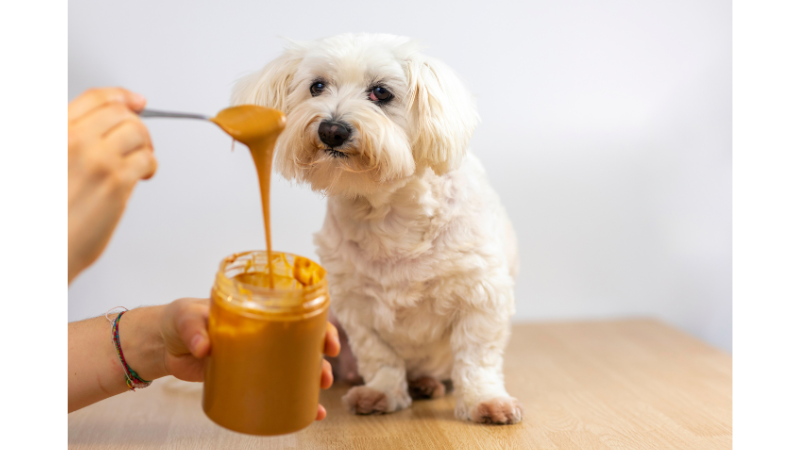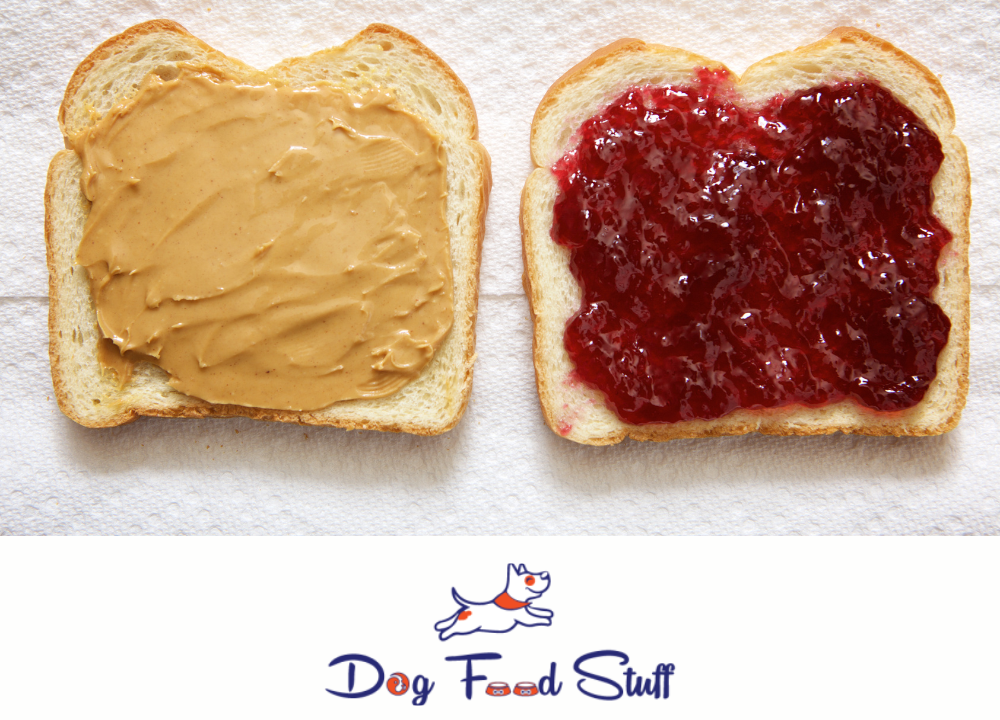Let’s Find Out Can Dogs Eat Peanut Butter And Jelly
Dogs can eat peanut butter in moderation but jelly often contains too much sugar. Be cautious as some peanut butter brands contain xylitol, toxic to dogs.
Dog owners often seek safe human foods to share with their furry companions. Peanut butter, a favorite treat for many canines, is generally safe in small amounts if it doesn’t contain xylitol, an artificial sweetener harmful to dogs. When it comes to jelly, it’s not the best choice for your pet due to its high sugar content and potential for harmful additives.
Offering your dog a lick of peanut butter can be a useful way to administer medication or provide a distraction during grooming. Always select natural, unsweetened peanut butter and use it as an occasional treat rather than a dietary staple. Check ingredients carefully and consult your veterinarian before introducing new foods to your pet’s diet to ensure their health and safety.
Can Dogs Eat Peanut Butter
Dogs love treats. Peanut butter can be a tasty and nutritious snack for our furry friends. But, it’s important to understand the right type and amount before sharing this human delicacy with them. Let’s explore the health benefits, potential risks, and the safest ways to feed peanut butter to dogs.
Health Benefits Of Peanut Butter
Peanut butter is packed with valuable nutrients for dogs:
- Protein supports muscle development.
- Healthy fats promote a shiny coat.
- Vitamins B and E help with cell function and immunity.
These elements make peanut butter a useful treat in moderation.
Risks And Considerations
Not all peanut butters are safe for dogs:
| Ingredient | Risk |
|---|---|
| Xylitol | Highly toxic to dogs |
| Salt | Excess is harmful |
| Sugar | Can lead to obesity |
Always check labels for xylitol, high salt, or sugar content.
Safe Ways To Feed Peanut Butter To Dogs
Follow these guidelines for safe feeding:
- Select plain, unsalted peanut butter without sweeteners.
- Offer only small amounts as occasional treats.
- Monitor your dog for any allergic reactions.
- Use peanut butter to hide medication or as training rewards.
Remember, even safe treats should only make up 10% of your dog’s diet.
With the right preparation, peanut butter can be a great treat. Choose wisely and enjoy seeing your dog’s tail wag with delight!
Can Dogs Eat Jelly
Dog owners often wonder about the safety of human foods for their pets. Peanut butter and jelly sandwiches are a classic, but it is vital to consider the ingredients separately for your furry friend. Let’s unravel the mystery behind jelly and its suitability for dogs.
Potential Risks Of Feeding Jelly To Dogs
Jelly might seem harmless, but it can pose several risks to your dog. High sugar content is the primary concern, as it can lead to obesity and dental problems. Not all jelly is made equal, and some contain xylitol, an artificial sweetener that’s toxic to dogs.
Here are the potential risks:
- Obesity: Excess sugar contributes to weight gain.
- Dental Issues: Sugary foods can cause cavities.
- Xylitol Toxicity: Even small amounts can be deadly.
- Gastrointestinal Distress: Jelly can cause upset stomachs.
- Allergic Reactions: Some dogs may react to certain fruits or additives.
Alternative Dog-friendly Spreads
If you’re seeking a safer treat for your pooch, consider alternative spreads. These are nutritious and dog-safe.
| Spread Type | Benefits |
|---|---|
| Plain Peanut Butter | High in protein and healthy fats. |
| Pumpkin Puree | Rich in fiber and vitamins. |
| Apple Sauce | Low in calories and sweet naturally. |
Always choose spreads with no added sugar or xylitol. Serving size is also key to maintain your dog’s health.
What To Do If Your Dog Eats Peanut Butter And Jelly
Discovering your dog snacking on peanut butter and jelly can be alarming. There’s a mix of good and bad news here. Most dogs can safely consume a small amount of peanut butter. Yet, jelly, often laden with sugar or xylitol, could be harmful. We will guide you through the steps to ensure your furry friend remains happy and healthy after such an indulgent accident.

Signs Of Allergic Reaction
Be watchful for unusual symptoms post-snack. Dogs, like people, may have allergies to nuts. An allergic reaction can be severe and requires prompt attention.
- Difficulty breathing
- Swelling of the face or paws
- Hives or red skin
- Excessive itching or scratching
- Sudden onset of diarrhea or vomiting
Contact your vet right away if you notice these signs. Act quickly to keep your dog safe.
Handling Digestive Issues
Stomach upset can occur after indulging in this human treat. The high sugar content in jelly is a culprit, potentially leading to gastrointestinal distress.
| Problem | Immediate Action | Follow-Up Care |
|---|---|---|
| Upset Stomach | Offer water. Reduce food intake. | Provide bland meals, like boiled chicken and rice. |
| Diarrhea | Ensure hydration. Monitor closely. | Visit the vet if it persists for more than 24 hours. |
| Vomiting | Remove food for 12 hours but give small water amounts. | If vomiting continues, seek veterinary attention. |
Note signs of distress and comfort measures. Rest and a gentle diet often aid recovery. Consult your vet for persistent or severe symptoms. Your dog’s health comes first!
Healthy Homemade Treats For Dogs
Every dog owner loves to spoil their furry friend with treats. Sometimes it’s tempting to give them human snacks like peanut butter and jelly. But dogs have different nutritional needs. Luckily, you can make healthy homemade treats that your dog will love. These treats are not just safe. They are also packed with goodness. Your dog’s tail will wag with joy for these delicious, nutritious snacks!
Peanut Butter And Jelly Alternatives
Dog-safe peanut butter is a tasty treat option. Always choose unsalted and xylitol-free peanut butter. Xylitol is toxic to dogs. For jelly, replace sugary jams with fresh, mashed fruits like blueberries or strawberries. These alternatives are not just healthy. They provide essential vitamins and fiber. Plus, they keep the treat enjoyable and safe for your pup’s palate.
Recipes For Dog-friendly Snacks
Ready to treat your dog? Here are some simple recipes for dog-friendly snacks:
- Peanut Butter and Banana Pupsicles
- Pumpkin and Oat Cookies
- Apple and Peanut Butter Bites
Dog Snack Ingredients and Steps
| Snack | Ingredients | Steps |
|---|---|---|
| Peanut Butter and Banana Pupsicles | Peanut butter, bananas, water | Mix, pour into molds, freeze |
| Pumpkin and Oat Cookies | Pumpkin puree, oats, eggs | Combine, shape, bake |
| Apple and Peanut Butter Bites | Apple slices, peanut butter | Spread, cut into pieces |
These snacks are easy to make. They use simple ingredients that are good for dogs. Your companion can enjoy these treats without the worry of harmful additives.
Frequently Asked Questions
Can I Give My Dog Peanut Butter And Jelly?
Yes, dogs can eat peanut butter in moderation, but jelly often contains too much sugar and can be harmful to your dog’s health. Always choose unsweetened, xylitol-free peanut butter.
What Happens If A Dog Eats A Peanut Butter And Jelly Sandwich?
A dog eating a peanut butter and jelly sandwich may experience mild to moderate digestive upset. Check for xylitol in peanut butter, as it’s toxic to dogs. If present, contact a vet immediately. Otherwise, watch for any unusual behavior or distress.
Can Dogs Eat Peanut Butter?
Yes, dogs can eat peanut butter in moderation. Ensure it’s free from xylitol, a sweetener harmful to dogs. Always choose unsweetened, natural peanut butter.
Which Brands Of Peanut Butter Are Safe For Dogs?
Most peanut butter brands without xylitol, a sweetener toxic to dogs, are safe. Check labels for natural, no sugar added options like Smucker’s Natural or Crazy Richard’s. Always avoid those with artificial sweeteners.
Conclusion
As pet parents, it’s crucial to prioritize our furry friend’s health. Peanut butter and jelly might be a tasty treat, but moderation is key. Always opt for dog-safe peanut butter and avoid jellies high in sugar or xylitol. Remember, a well-balanced diet and regular check-ups are vital for your dog’s wellness.
Treat wisely and enjoy bonding over safe snacks!

